Connect With Us
Blog
Items filtered by date: December 2021
Foot and Ankle Injuries in Ballet Dancers
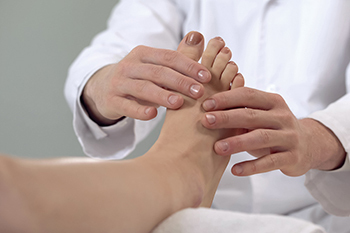
Foot and ankle injuries are sometimes an unavoidable part of a dancer’s life, and particularly so for ballet dancers. Overuse injuries are more common in ballet than traumatic injuries, as they can be attributed to repetitive movements and extraordinary stress on bones and soft tissue structures. Achilles tendinopathy is one example of this type of injury. This is often the result of excessive stress on the Achilles tendon due to exaggerated positions such as demi-plié, demie point, and en pointe. Flexor hallucis longus tendinopathy is an overuse injury that can occur from repeated pushing off from the big toe. The pirouettes ballet dancers perform put an incredible amount of pressure on the forefoot, which can cause a nerve disorder called Morton’s neuroma. Landing after jumps and rolling the foot down from demie point places repeated tension on the plantar fascia tissue on the sole of the foot. This can cause the tissue to become inflamed or torn (plantar fasciitis). A podiatrist has immeasurable experience in diagnosing and treating foot and ankle conditions of all kinds, and should be consulted for any such injury a dancer or athlete may incur.
Sports related foot and ankle injuries require proper treatment before players can go back to their regular routines. For more information, contact Stephen Boykins, DPM of SoCal Podiatry, P.C.. Our doctor can provide the care you need to keep you pain-free and on your feet.
Sports Related Foot and Ankle Injuries
Foot and ankle injuries are a common occurrence when it comes to athletes of any sport. While many athletes dismiss the initial aches and pains, the truth is that ignoring potential foot and ankle injuries can lead to serious problems. As athletes continue to place pressure and strain the area further, a mild injury can turn into something as serious as a rupture and may lead to a permanent disability. There are many factors that contribute to sports related foot and ankle injuries, which include failure to warm up properly, not providing support or wearing bad footwear. Common injuries and conditions athletes face, including:
- Plantar Fasciitis
- Plantar Fasciosis
- Achilles Tendinitis
- Achilles Tendon Rupture
- Ankle Sprains
Sports related injuries are commonly treated using the RICE method. This includes rest, applying ice to the injured area, compression and elevating the ankle. More serious sprains and injuries may require surgery, which could include arthroscopic and reconstructive surgery. Rehabilitation and therapy may also be required in order to get any recovering athlete to become fully functional again. Any unusual aches and pains an athlete sustains must be evaluated by a licensed, reputable medical professional.
If you have any questions please feel free to contact our offices located in Downey and Moreno Valley, CA . We offer the newest diagnostic and treatment technologies for all your foot and ankle needs.
Heel Pain
Heel pain can be difficult to deal with, especially if you do not know what the underlying cause is. If you ignore your heel pain, the pain can magnify and potentially develop into a chronic condition. Depending on the location of your heel pain, you have developed a specific condition.
One condition is plantar fasciitis. Plantar fasciitis is caused by the inflammation of the plantar fascia, or the band of tissue that connects the heel bone to the base of the toes. The pain from this condition is initially mild but can intensify as more steps are taken when you wake up in the morning. To treat this condition, medication will likely be necessary. Plantar fasciitis is often associated with heel spurs; both require rest and special stretching exercises.
There are various options your podiatrist may suggest for heel pain. Treatment options for heel pain typically include non-steroidal anti-inflammatory drugs (NSAIDS), which may reduce swelling and pain. Other options are physical therapy, athletic taping, and orthotics. In severe cases of heel pain, surgery may be required.
Preventing heel pain is possible. If you are looking to prevent heel pain from developing in the future, be sure to wear shoes that fit you properly and do not have worn down heels or soles. Be sure to warm up properly before participating in strenuous activities or sports that place a lot of a stress on the heels. If you are experiencing any form of heel pain, speak with your podiatrist to determine the underlying cause and receive the treatment you need.
Heel Pain Can Come From Various Sources
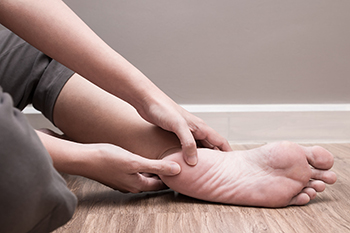
There are many different reasons why people can feel heel pain. It can be a result of having Achilles tendonitis, a heel spur, or plantar fasciitis. These are the most common causes, and there are various ways the heel bone can be negatively affected. Heel pain can consist of a stabbing, burning pain, or it may be a chronic dull ache. It may be worse upon waking up in the morning, and walking can be difficult. Plantar fasciitis is the inflammation of the plantar fascia, the band of tissue that runs along the sole of the foot. Its function is to connect the heels to the toes, in addition to providing stability to the arch. People who enjoy running or who frequently participate in jumping activities may develop this condition, and it can cause severe pain and discomfort. A heel spur is defined as a bony growth that forms on the back of the heel bone, and it can come from extra bone tissue that can be caused by plantar fasciitis. The Achilles tendon is located in the calf, and it connects the heel to the calf muscles. This tendon can become torn or ruptured from an injury, and cause heel pain. If you are experiencing heel pain for any reason, it is strongly advised that you are under the care of a podiatrist who can determine what the cause is, and offer you correct treatment options.
Many people suffer from bouts of heel pain. For more information, contact Stephen Boykins, DPM of SoCal Podiatry, P.C.. Our doctor can provide the care you need to keep you pain-free and on your feet.
Causes of Heel Pain
Heel pain is often associated with plantar fasciitis. The plantar fascia is a band of tissues that extends along the bottom of the foot. A rip or tear in this ligament can cause inflammation of the tissue.
Achilles tendonitis is another cause of heel pain. Inflammation of the Achilles tendon will cause pain from fractures and muscle tearing. Lack of flexibility is also another symptom.
Heel spurs are another cause of pain. When the tissues of the plantar fascia undergo a great deal of stress, it can lead to ligament separation from the heel bone, causing heel spurs.
Why Might Heel Pain Occur?
- Wearing ill-fitting shoes
- Wearing non-supportive shoes
- Weight change
- Excessive running
Treatments
Heel pain should be treated as soon as possible for immediate results. Keeping your feet in a stress-free environment will help. If you suffer from Achilles tendonitis or plantar fasciitis, applying ice will reduce the swelling. Stretching before an exercise like running will help the muscles. Using all these tips will help make heel pain a condition of the past.
If you have any questions please contact our offices located in Downey and Moreno Valley, CA . We offer the newest diagnostic and treatment technologies for all your foot and ankle needs.
Diabetic Limb Salvage
Limb salvage is a procedure that involves saving a lower extremity from amputation. In podiatry, limb amputation often occurs as a result of diabetes. The fundamental goal of limb salvage is to restore and maintain stability and movement of the affected lower extremity.
The procedure typically involves removing the diseased tissue and a small portion of the surrounding healthy tissue, as well as the removal of any affected bone if necessary. If bone is removed it is then replaced with prostheses, or synthetic metal rods or plates, or grafts from either the patient’s body or a donor. Limb salvage is typically the preferred choice of procedure over amputation, as the procedure preserves both the patient’s appearance and allows for the greatest possible degree of function in the affected limb.
Upon diagnosis and determining that limb salvage is the appropriate treatment, the podiatrist may enlist the help of a physical and/or occupational therapist to prepare the patient for surgery by introducing various muscle-strengthening, walking, and range of motion exercises. Such exercises may be continued as rehabilitation post-procedure.
Facts About Diabetes and Amputation
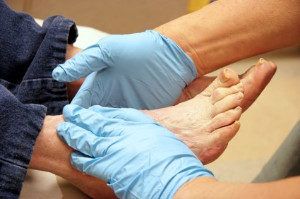
Nerve and circulatory damage resulting from diabetes is common and can lead to injuries to the feet and lower legs. In extreme cases, amputation is required. Amputations are the end result of foot or leg ulcers that did not heal or cannot heal. Diabetic neuropathy and peripheral artery disease (PAD) are contributing factors to this occurrence. Neuropathy makes it hard to detect cuts and sores, which may become infected. PAD then slows the healing process, causing ulcers, which if left unattended can lead to gangrene. At some point removing the ulcerated area can give way to removing the foot or limb. The two main actions that may help to keep this chain reaction from occurring are blood sugar maintenance and proper foot care. Reducing stress and eating healthy food is a good beginning. Refraining from smoking and alcohol consumption, both of which contribute to nerve damage and poor circulation, is highly recommended by experts. Losing weight and keeping track of blood sugar levels is essential. Daily foot care is imperative, including keeping feet clean and dry and checking for sores, cuts, and blisters. Moving the toes and feet to encourage better blood flow and wearing shoes that fit properly also help. If you have questions regarding proper diabetic foot care, please visit a podiatrist as soon as possible.
Diabetic Limb Salvage
Diabetic limb salvage can be an effective way in preventing the need for limb amputation. If you have a foot ulcer and diabetes, consult with Stephen Boykins, DPM from SoCal Podiatry, P.C.. Our doctor will assess your condition and provide you with quality foot and ankle treatment.
What Is Diabetic Limb Salvage?
Diabetic limb salvage is the attempt of saving a limb, such as the foot, that has an infected ulcer, from amputation. Podiatrists also try to make sure that there is enough function in the foot after the salvage that it is still usable. Those with diabetes experience poor blood circulation, which prevents proper healing of an ulcer. If the ulcer is left uncheck, it could become infected, which could result in the need for amputation.
Diabetes is the number one cause of non-traumatic amputations in the United States. Amputation has been found to lead to higher mortality rates. This translates into higher healthcare costs, and a reduced quality of life and mobility for amputees. Podiatrists have attempted to increase the prevalence of limb salvage in an attempt to solve these issues.
Diagnosis and Treatment
Limb salvage teams have grown in recent years that utilize a number of different treatments to save the infected limb. This includes podiatrists that specialize in wound care, rehabilitation, orthotics, and surgery. Through a combination of these methods, limb salvage has been found to be an effective treatment for infected limbs, and as an alternative to amputation. Podiatrists will first evaluate the potential for limb salvage and determine if the limb can be saved or must be amputated.
If you have any questions, please feel free to contact our offices located in Downey and Moreno Valley, CA . We offer the newest diagnostic and treatment technologies for all your foot care needs.
Toe Pain
Toe pain can originate from corns, calluses, hammertoes, and bunions, as well as ingrown toenails, sprains, fractures, and dislocations. Corns develop as the toe rubs against the inside of a shoe which causes the skin to thicken as a form of protection. A corn is typically cone-shaped and has a small, hardened spot that points inward. When a corn is pressed into the skin, the toe becomes painful. Corns usually form on the top or side of the toe. A callus is also a thickened patch of skin that generally forms on the bottom of the foot. Calluses are the result of friction from the toe rubbing against the inside of a shoe. They may also occur by walking barefoot or having flat feet. A hammertoe is a bump on the knuckle of the second toe that is produced by wearing shoes that are too short for your feet. The bony protrusion rubs against the top of the shoe causing pain and irritation. A bunion is a malformation of the big toe. The base of the big toe pushes away from the smaller toes, forcing the top of the big toe to press toward the other toes. Bunions can be hereditary, or they can result from injury to the toe joint or from wearing high heels with a narrow toe box. The toe becomes inflamed, and a bump may develop at the end of the misplaced bone. Ingrown toenails typically affect the big toe and its surrounding skin. The nail will dig into the skin and become painful. Wearing tight or narrow shoes that compress the big toe causes the nail to grow into the fleshy part of the toe. Cutting toenails incorrectly can also add to the development of an ingrown toenail. A toe sprain originates from a torn or stretched ligament. Strapping the injured toe to the toe next to it for stabilization is common. A broken or fractured toe usually occurs from trauma like dropping a heavy object on it or bumping into something extremely hard and rigid. Osteoporosis, a thinning of the bones, can also bring about toe fractures.
Any of the conditions mentioned can lead to pain and irritation. While some are more serious than others, seeking an examination and diagnosis from a podiatrist is a good idea. A podiatrist can treat each ailment and get you back on your feet again without pain.
What Is Hallux Rigidus?
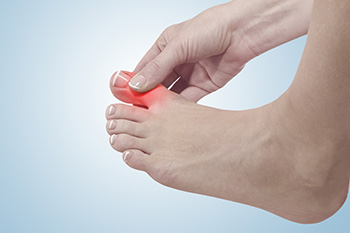
Hallux rigidus is a condition that typically affects the joint between the first long bone of the foot and the big toe. It is called the metatarsophalangeal joint, or MTP for short. Pressure on the bones, ligaments, and tendons of the MTP joint caused by wearing ill-fitting shoes or standing for long periods of time can result in inflammation. The big toe becomes stiff and painful, making it difficult to walk with a normal gait. A faulty distribution of body weight further aggravates the joint and can lead to the destruction of the cartilage. The big toe will hurt when it is moved up and down and sometimes a bone spur will form on the end of the first metatarsal bone. Alterations to footwear, such as avoiding high heels and wearing shoes with a roomier toe box, can bring some relief, but will not stop the progression of the hallux rigidus. It is wise to treat it early for better results. If the stiffness in the big toe does not go away after a few days, please seek the guidance of a podiatrist, who may prescribe both medication and custom orthotics. In more advanced cases, surgery may be an option.
Toe pain can disrupt your daily activities. If you have any concerns, contact Stephen Boykins, DPM of SoCal Podiatry, P.C.. Our doctor can provide the care you need to keep you pain-free and on your feet.
What Causes Toe Pain?
Most severe toe pain is caused due to a sports injury, trauma from dropping something heavy on the toe, or bumping into something rigid. Other problems can develop over time for various reasons.
Toe pain can be caused by one or more ailments. The most common include:
- Trauma
- Sports injury
- Wearing shoes that are too tight
- Arthritis
- Gout
- Corns and calluses
- Hammertoe
- Bunions
- Blisters
- Ingrown toenails
- Sprains
- Fractures (broken bones)
- Dislocations
When to See a Podiatrist
- Severe pain
- Persistent pain that lasts more than a week
- Signs of infection
- Continued swelling
- Pain that prevents walking
Diagnosis
In many cases the cause of toe pain is obvious, but in others, a podiatrist may want to use more advanced methods to determine the problem. These can range from simple visual inspections and sensation tests to X-rays and MRI scans. Prior medical history, family medical history, and any recent physical traumatic events will all be taken into consideration for a proper diagnosis.
Treatment
Treatments for toe pain and injuries vary and may include shoe inserts, padding, taping, medicines, injections, and in some cases, surgery. If you believe that you have broken a toe, please see a podiatrist as soon as possible.
If you have any questions please feel free to contact our offices located in Downey and Moreno Valley, CA . We offer the newest diagnostic tools and technology to treat your foot and ankle needs.
Are Bunions Affecting Your Everyday Life?
Everyday Foot Care
Our feet are arguably one of the most important parts of the body. When it comes to health and beauty routines, the feet and toenails are usually ignored. You should always practice proper footcare to avoid any fungal infections or ailments that can not only ruin the appearance of your feet, but also cause pain. Ignoring any foot problems could potentially lead to an expensive doctor’s visit.
The most important step in proper foot care is to wash your feet daily. You should wash them with soap and water. Doing this will cleanse your feet of dirt, sweat and bacteria. It is crucial that you clean between the toes and pat your feet dry with a towel afterward. Your toenails are also an important part of the feet and you may find that they get dirtier in the summer when you wear sandals. It is important that you practice proper toenail care in addition to cleaning the rest of your feet. When trimming your nails, you should always trim straight across instead of in a rounded shape. Trimming in a curved shape may lead to ingrown toenails.
Moisturization is also important for foot care, and you should be moisturizing your feet every day. The best way to prevent dry feet is to rub lotion or petroleum jelly on your clean feet at night and put socks over them. In the morning, your feet should be soft and moisturized.
Another crucial step in proper foot care is to wear the right shoes for whichever activity you are going to partake in. In warmer weather, you should wear shoes that allow your feet to breathe. It is best to avoid shoes such as flip-fops that do not provide arch support. Tight shoes may also be harmful, and they may even cause you to develop bunions.
If you plan on taking a shower in a public area, you should be especially careful, so you do not pick up any fungi. Showers are prone to harboring different types of bacteria and fungi. You should always wear shower shoes or flip flops when walking around in locker rooms and public showers. Avoid sharing shoes with other people because this is another way that fungus may be spread.
If you are experiencing any problems with your feet you should speak with your podiatrist to determine the best method of treatment for you.
Using a Pumice Stone
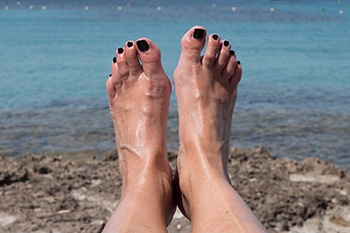
Although a podiatrist can help you maintain the health of your feet, there are many things that you can do every day to practice proper foot health. For example, people other than those with diabetes might consider incorporating a pumice stone into their foot care routine. However, it is important to know exactly how a pumice stone should and should not be used. Pumice stones can be used on the feet to target and remove dry or dead skin. Most commonly, individuals might use a pumice stone to remove dead skin on the heels and around the toes. To use a pumice stone, soak the feet in warm, soapy water for 10 to 15 minutes. Also be sure to soak the stone, as you do not want to apply a dry stone to the skin. Apply the stone to the target area, using small circular motions, gently applying a small amount of pressure. Importantly, if you apply too much pressure, you might remove too much skin. After application, rinse your skin and the pumice stone then pat your feet dry. You might even finish up the routine by applying a moisturizer to the feet. Contact a podiatrist to see if adding a pumice stone into your daily foot care routine is right for you.
Everyday foot care is very important to prevent infection and other foot ailments. If you need your feet checked, contact Stephen Boykins, DPM from SoCal Podiatry, P.C.. Our doctor can provide the care you need to keep you pain-free and on your feet.
Everyday Foot Care
Often, people take care of their bodies, face and hair more so than they do for their feet. But the feet are a very important aspect of our bodies, and one that we should pay more attention to. Without our feet, we would not be able to perform most daily tasks.
It is best to check your feet regularly to make sure there are no new bruises or cuts that you may not have noticed before. For dry feet, moisturizer can easily be a remedy and can be applied as often as necessary to the affected areas. Wearing shoes that fit well can also help you maintain good foot health, as well as making it easier to walk and do daily activities without the stress or pain of ill-fitting shoes, high heels, or even flip flops. Wearing clean socks with closed shoes is important to ensure that sweat and bacteria do not accumulate within the shoe. Clean socks help to prevent Athlete’s foot, fungi problems, bad odors, and can absorb sweat.
If you have any questions please feel free to contact our offices located in Downey and Moreno Valley, CA . We offer the newest diagnostic and treatment technologies for all your foot and ankle needs.

